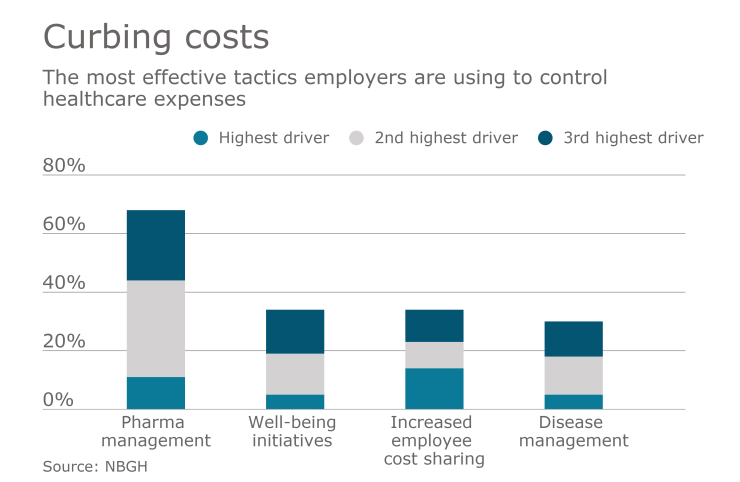In a competitive economy, a robust package of employee health benefits is one of the key elements that employers need to attract and to retain a skilled, experienced workforce. In fact, according to statistics gathered by Collective Health and Harris Poll, 78% of adults in the U.S. say healthcare benefits strongly factor into their decision on where to accept a job.
However, once employees have these benefits, most do not take full advantage of the complete range of services and support available. Only 25% of employees questioned in one survey said they have used all the preventive care benefits offered by their employer. Another survey, conducted by the American Psychological Association, found that only 33% of employees report participating in employer-provided health promotion programs.

The failure to engage with and use the benefits available can have an especially significant impact when employees or their family members face serious or complex medical issues, such as a cancer diagnosis or recommendation for surgery. When employees don’t use the full spectrum of benefits available to them, such as second opinions and case management, the risk of poorer health outcomes and higher employer and employee healthcare costs increases, with more than $210 billion a year spent on inappropriate and unnecessary treatment according to an Institute of Medicine report.
Several factors contribute to employees’ failure to use all the health benefits available to them:
· Problems with the benefits selection process: Although the choice of benefits can have wide ranging effects on both physical and financial health, 77% of employees spend 60 minutes or less choosing benefits, while 46% spend 30 minutes or less on this important decision, according to an Aflac poll. Another survey noted the high stress levels associated with making benefit decisions, finding that 49% of employees say making benefits decisions is always stressful.
· Not understanding the options: A survey by the International Foundation of Employee Benefits Plans found that approximately 80% of organizations reported that employees do not have a high level of understanding of their benefits. This lack of understanding comes at a financial cost. According to 42% of employees in the Aflac survey, the estimated cost of errors employees make understanding and choosing benefits can cost them up to $750 per year.
· Complexity of benefits: When faced with multiple benefit providers and contact points, employees often do not know where to find the information they need to understand the benefits available to them and how to access them. As a result, employees fail to access the information, resources and support that can help them make informed medical decisions. This can have a negative impact on health outcomes and healthcare costs.
· Lack of trust in benefit providers: Employees may not trust the advice of benefit providers such as insurance companies because they are unsure whether the goal of the advice is acquiring the best care or to lowering the cost of claims. That lack of trust may cause employees not to engage with services like case management or not to follow the recommendations offered by benefit providers.
Opportunities to enhance employee engagement
There are four key opportunities for employers to increase employee engagement with health benefits. These approaches can improve health outcomes and reduce spending on inappropriate care:
Preventive opportunities. These opportunities focus on programs, tools and technologies that increase employee engagement to prevent the onset or progression of serious medical conditions through better lifestyle habits and behavior. Some examples include:
· Employer-sponsored wellness programs, such as on-site fitness and stress management programs
· Employee assistance programs
· Incentives, such as health insurance discounts for using fitness trackers or participating in wellness and health promotion programs
· Technology tools, including apps, to assist in the management of chronic health problems such as diabetes, heart disease and asthma
· Employer-sponsored preventive health screenings
Predictive opportunities. These opportunities focus on the analysis of insurance claims data to identify medical issues that may be a trigger for high medical spending, for example, a biopsy that precedes a cancer diagnosis. The goal is to identify employees for outreach to help guide them to the care and support resources they need to manage their illness and make more informed decisions about their care and treatment options.
Emergent opportunities. These opportunities address emerging and serious medical issues that can make it difficult for employees to objectively assess their next steps, for example a cancer diagnosis or recommendation for back surgery. The goal is to connect employees with the most appropriate medical specialists and centers of excellence that can provide an expert medical opinion on their diagnosis and appropriate course of treatment.
Prescriptive opportunities. These opportunities use a case management approach to triage and oversee the care plan for treatment of serious and complex medical conditions, usually focused on a specific category of disease such as cancer or congestive heart failure. In these cases, employees are directed to experienced specialists and nurse case managers, psycho-social support programs and other benefit providers that can facilitate access to long- or short-term disability and Family and Medical Leave Act benefits.
For all these approaches, it’s essential that employers communicate clearly and frequently to employees to ensure they’re aware of the programs available and know how and when to access them. Without that communication to build awareness, employees, especially those facing a serious illness, may be overwhelmed and withdraw rather than engaging with the support available.





